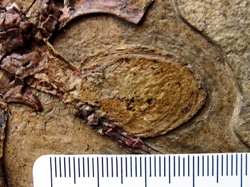
David Unwin, (University of Leicester), who was part of the research team, says: “Many pterosaurs have head crests. These can reach five times the height of the skull. Scientists have long suspected that they were used for display or signalling, and may have been confined to males. But in the absence of any direct evidence for gender, this idea remained speculative.”
As a result, crested and crestless forms were often separated into completely different species, Unwin says. “This type of discovery, in which gender can be determined with certainty, is extremely rare in the fossil record, and the first to be reported for pterosaurs.”
The specimen, christened “Mrs T” (a contraction of “Mrs Pterodactyl”) by the research team, was made in Liaoning Province in NE China, and may represent the result of a tragic accident. The well-developed shell shows that Mrs T was just about ready to lay her egg when she broke her left forearm and was killed - possibly in a storm, or even a volcanic eruption, which were common in this part of China just then.